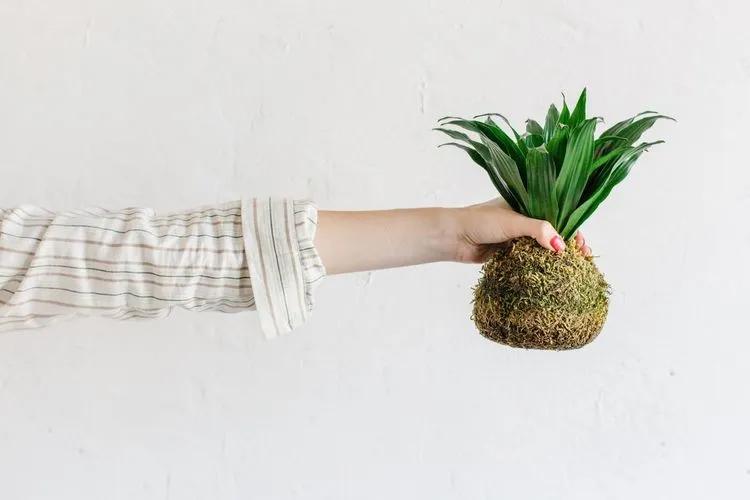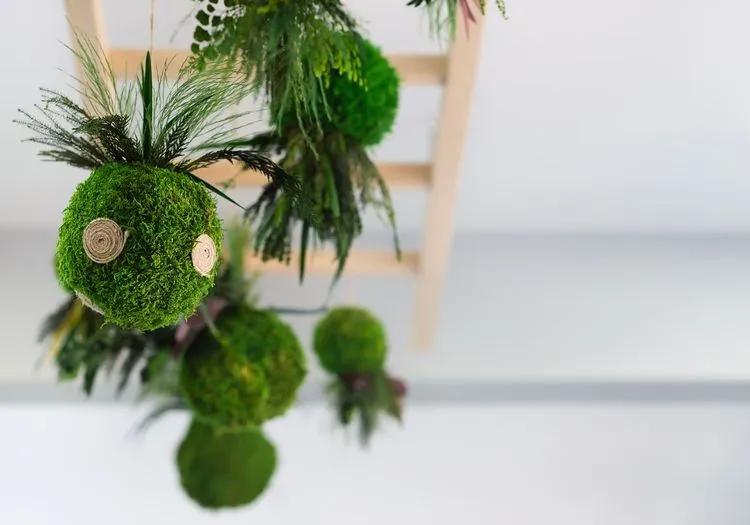Kokedama: what is it and how to do it?
How to diversify your home oasis with unusual decoration? Japanese culture have the answer! Read about kokedama, traditional method of arranging houseplants using moss.
What is kokedama?
 Japanese are known for their devotion to everyday aesthetics, and the unusual concept of kokedama is an excellent example of it. It shows that you can turn an ordinary object into something more sophisticated. The best description of kokedama is hidden in its name – 'koke' means 'moss' and 'dama' means 'ball,' so it is the mass ball.
Japanese are known for their devotion to everyday aesthetics, and the unusual concept of kokedama is an excellent example of it. It shows that you can turn an ordinary object into something more sophisticated. The best description of kokedama is hidden in its name – 'koke' means 'moss' and 'dama' means 'ball,' so it is the mass ball.
To be precise, kokedama is a hanging plant spaced in a mass ball without a pot. It isn't utterly novel because hanging plants or even the hanging gardens were known centuries ago, for example, the Hanging Gardens of Babylon. And kokedama itself wasn't invented just recently: it was created in Edo Period (1603-1868).
To understand this type of decoration, take a look at wabi-sabi. It's a worldview that is centered on the appreciation of imperfections, finding beauty in them. Key characteristics of this aesthetic are asymmetry, economy, simplicity, etc. That's why kokedama is sometimes called the embodiment of wabi-sabi. And maybe that's the reason why kokedama is sometimes considered 'bonsai for a poor man.' They are very similar: kokedama is akin to bonsai, but it doesn't require an expensive pot and regular time-consuming care.
Which plants are the best for kokedama?
 Choosing the right plant is the key to success: chosen plant shouldn't be only pretty but suitable for such conditions. Shortly, the best plants for kokedama are not supposed to grow big, their leaves are not extremely wide, and they are not picky when it comes to watering. Suitable species include mint, spider plant, orchids, angel hair vine, dwarf varieties of different plants, and the following ones.
Choosing the right plant is the key to success: chosen plant shouldn't be only pretty but suitable for such conditions. Shortly, the best plants for kokedama are not supposed to grow big, their leaves are not extremely wide, and they are not picky when it comes to watering. Suitable species include mint, spider plant, orchids, angel hair vine, dwarf varieties of different plants, and the following ones.
-
Epiphytic plants are very suitable for kokedama. You can choose pothos: it has beautiful foliage, and you can regulate its growth. And since epiphytic plants are used to grow on another organism, they will get settled very quickly.
-
Bromeliads. You can choose tiger cubs. Naturally, they aren't big plants, which means they won't outgrow their moss ball.
-
Succulents do not grow fast and can handle a lack of water without problems, making them an excellent choice for kokedama. Please pay attention to zebra cactus or semi-succulent ivy peperomia.
-
Ferns are one of the best plants for kokedama because they are not sensitive to low humidity. But there are some varieties with different characteristics, so pay attention to the species you are selecting. We recommend blue star fern or rabbit's foot fern.
-
Peace lilies. If you want your kokedama to be adorned with flowers, then these flowers are a good solution! But be careful, this plant is a little bit sensitive, underwatering can harm their wellbeing. This plant grows fast, so your kokedama won't stay longer than several seasons.
-
Croton. If you want to place your kokedama next to windows, choose sunlight-tolerating plants. Usually, crotons tend to grow big, but you can control their growth. Just trim the roots, place them in a small space, and don't fertilize.
Kokedama DIY
 You will need a plant, bonsai mix, moss, potting compost, bucket, scissors, spray, and garden twine.
You will need a plant, bonsai mix, moss, potting compost, bucket, scissors, spray, and garden twine.
Step 1. Create a mixture of potting compost and bonsai mix, add a little water to it.
Step 2. Remove the chosen plant from the pot, expose the majority of roots by loosening the original compost.
Step 3. Make a ball and divide it into two parts from that mixture of potting compost and bonsai mix.
Step 4. Place your plant inside of this mixture; after that, form the soil mixture to look like a ball and cover it with moss.
Step 5. Wrap some twine around it to make it stable, and remember, the string needs to be strong because it will carry the weight of the kokedama.
Care advices
Kokedama doesn't like direct sunlight, so place it somewhere when it can get a sufficient amount of diffused sunlight. Water the composition regularly, about 1-2 times a week, but pay attention to the chosen plant’s watering preferences. The weight of kokedama can be used as a sign if it needs water. If this is light, then you need to water it.
Once a week, kokedama requires bathing. There are two types of baths: 10-12 minutes with a complete immersion and 30 minutes, but only 20% of kokedama should be lowered into the water. Do not forget that watering depends on the plant that you have chosen for your kokedama.
